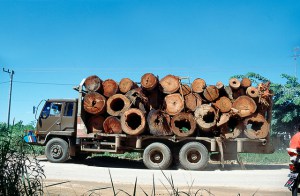
Research to improve partnership among stakeholders of a pulpwood plantation on the Indonesian Island of Sumatra has strengthened the negotiating power of local communities, easing two decades of conflict and boosting livelihoods in a region where 48 percent of people live below the poverty line.
The research was a response to the failure of the existing partnership between the plantation company and surrounding communities to settle disputes about land ownership, and conflict among locals over compensation payments for land lost to the 296,400-hectare (732,420-acre) plantation.
In some cases, the conflicts over who was entitled to compensation had escalated to violence, according to the paper, “Communicative Action to Level the Playing Field in Forest Plantations in Indonesia,” published recently in The Journal of Sustainable Forestry.
Lead author Herry Purnomo of the Center for International Forestry Research (CIFOR) said the research established a forum for more equitable negotiations, and that the approach could be used as a model throughout Indonesia, where the Ministry of Forestry announced plans in 2011 to further increase the amount of land already dedicated to plantations.
Although the land being offered to private plantation companies is formally classed as state land, in practice it is largely managed by local communities who depend on it for their livelihoods, the paper said. As a result, the Indonesian government has issued regulations that call for “joint management” of forest plantations.
Purnomo’s paper quoted previous research showing that expansion of pulp plantations in Indonesia has led to conflict over issues including land appropriation, environmental impacts and access to employment.
“Our study engaged local communities as research partners to identify problems and work together towards solutions,” Purnomo said.
“When the research began in 2005, 25 percent of the local population relied on the plantation for income in the form of wages for physical labor, salaries for office jobs and contracts for planting, weeding and harvesting,” he said.
Communities whose traditional lands fell within plantation boundaries also received production payments, based on a set price per cubic meter of wood (Acacia mangium) harvested, as well as management fees from the company.
“These initial partnerships, developed by the company, gave money to the local communities, but also produced conflict because it was not clear who deserved the production payments, or whether the amount of money paid was fair,” Purnomo said.
A central problem was the unequal power balance among the stakeholders, with money often going to village elites and not being fairly distributed, he said. There was also conflict between people who had traditional claims on plantation land but who lived outside the concession boundaries, and among new migrants who had moved to villages inside the plantation for work.
“I saw that the conflict was going to become violent if there was no facilitation process.”
Levelling the playing field
The study — part of a three-year project, “Levelling the Playing Field,” supported by the European Union — included a survey of households, stakeholder meetings and a forum.
There is more forest on the neighboring Indonesian island of Java now than there was five years ago because of planting by small-scale forestry plantations
According to Purnomo, the forum enabled community members to agree on how company payments should be more fairly distributed, and to negotiate for better timber prices and management fees, both of which the study found to be low.
The company agreed to offer exclusive plantation operation contracts to local communities with traditional ties to the land, and bylaws were determined to strengthen the partnership.
Communities outside the plantation, but with a traditional claim to land within it, expressed a desire to regain 25 percent of their land to re-establish rubber, oil palm and other plantations as sources of livelihoods. Improved access to employment was a common goal.
The paper acknowledged the long-term goal of agreed land tenure rights and reported that “the research process provoked social and political transformation.”
Purnomo noted that this research was based on Jürgen Habermas’ theory of communicative action, in which actors seek to coordinate actions by consensus and cooperation rather than by pursuing solely their own goals.
Environmental benefits
According to Purnomo, if local people are confident that they will receive a fair price for timber from plantation companies, they are more likely to work hard to replant and secure a good harvest the next time, reducing forest degradation and emissions linked to climate change. Such outcomes are relevant to programs including REDD+ (Reducing Emissions from Deforestation and Forest Degradation).
The framework for establishing more equitable partnerships resulting from this study could assist in the development of small-scale community plantations that work in partnership with large oil palm and pulpwood plantations, he said. “Such collaboration is necessary if small-scale producers are to compete against nations like China,” he said. “There is more forest on the neighboring Indonesian island of Java now than there was five years ago because of planting by small-scale forestry plantations.”
All stakeholders in the Sumatran pulpwood plantation study — the company, the community and the local government — requested the research and agreed that the company’s forest plantation must be sustained.
For more information about this research, contact Herry Purnomo at h.purnomo@cgiar.org.
This research forms part of the CGIAR Research Program on Forests, Trees and Agroforestry and was funded in part by the European Union.
We want you to share Forests News content, which is licensed under Creative Commons Attribution-NonCommercial-ShareAlike 4.0 International (CC BY-NC-SA 4.0). This means you are free to redistribute our material for non-commercial purposes. All we ask is that you give Forests News appropriate credit and link to the original Forests News content, indicate if changes were made, and distribute your contributions under the same Creative Commons license. You must notify Forests News if you repost, reprint or reuse our materials by contacting forestsnews@cifor-icraf.org.
